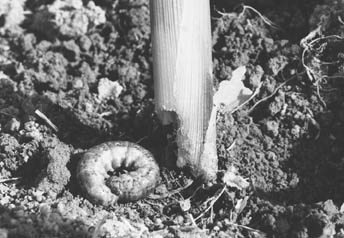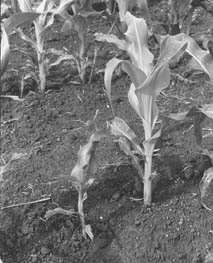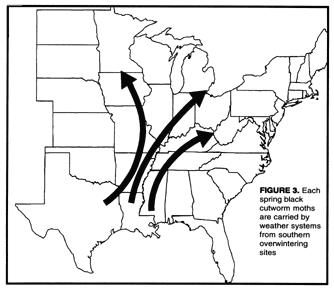Cutworm Management in Corn
ENT-59: Cutworm Management in Corn | Download PDF
by Ric Bessin, Extension Entomologist
University of Kentucky College of Agriculture
Cutworms are sporadic early-season pests that can reduce plant populations in a field. They often go unnoticed until after a significant number of plants have been damaged. Larger stages of cutworms cut entirely through the plant or tunnel into the plants below or above the soil line, whereas small-stage cutworms climb plants and chew small holes in the leaves.
While they are potentially very destructive, cutworms are unpredictable, and the chances of significant damage in any given year are relatively low. Corn can be seriously damaged by cutworms from planting through mid-June while the plants are less than 18 inches tall. Serious losses are often associated with wet springs that have caused a delay in planting.
Cutworms are the larvae of moths. These night-flying moths are frequently attracted to lights at night. The 1-1/2 to 2-inch moths are dull-gray to brown with yellow, gray, light brown, and black designs on the front wings. The hind wings are usually solid in color and lighter than the front wings. Moths lay eggs singly or in clusters on the leaves of grasses, weeds, other host plants, and sometimes on the bare ground.

Cutworm larva coiled into a "C" shape
Cutworms are smooth-skinned and somewhat shiny. They range in color from gray to dark brown with distinctive stripes and spots. When fully grown, cutworms can reach 1-3/4 inches in length. Cutworms commonly coil up in a “c” shape when disturbed.
Cutworms feed mostly at night and hide during the day under clods of soil or in burrows below the soil surface. They cut off the stalks of young plants at or just below the soil surface and feed on the buds or leaves. They rarely consume the entire plant, but more commonly move to the next plant in the row or to another row. Infestations typically are not uniform within a field, so the loss of a plant stand tends to occur only in parts of a field.
Extremely dry or wet soil conditions may affect cutworm behavior and the location where they may be found by the grower or scout. Under very dry soil conditions, cutworms restrict their movement to underground tunneling and feeding only where the soil moisture is greater. Under these conditions plants may be cut at varying depths below the soil surface, usually at or below the growing point. With normal or high soil moisture, cutting may be more above ground.

Corn regrowth following cutworm damage
Regrowth of cut seedlings is possible in some instances in corn depending on where the damage occurred relative to the growing point. In general, the higher the level of the cut and the earlier that this cutting occurs in seedling development, the greater the regrowth potential of the plant (pictured right). When cutting occurs above the growing point, there is a greater chance for recovery without substantially reducing the yield. Neighboring plants also compensate somewhat for lost or damaged plants.
Hosts Attacked
Cutworms are opportunistic pests that can feed on many weed species as well as cultivated crops. Besides being pests of field crops such as corn, soybeans, and tobacco, they can damage a wide range of vegetable crops such as tomatoes, eggplants, peppers, cole crops, cucurbits, and onions. Damage to some crops may be greater due to higher per-plant value. Yield compensation may not be possible on some crops with above-ground growing points. Because infestations often begin on weeds, cultivation and other weed-control programs implemented before planting time may increase cutworm feeding on seedling crops. Cutworms can survive for some time between cultivation and planting, so allow at least two weeks between weed control and planting.
In some crops, cutworms can be extremely damaging where transplants are planted through plastic. It has been reported that the increased heat radiating out at night, particularly around the bases of the plants, attracts the larvae to the plants. Once underneath the plastic, the larvae are very difficult to control.
Cutworm Species in Kentucky
Because the different cutworm species vary somewhat in their life cycles, conditions which govern their potential for infestation are not always the same. Among the different species of cutworms attacking corn in the commonwealth are the claybacked cutworm, the dingy cutworm, and the black cutworm, which is the most common and destructive.

Migration patterns of black cutworm moths from their southern overwintering sites.
Black Cutworm
This cutworm apparently does not overwinter well in the commonwealth except possibly in years with very mild winters. Spring infestations begin with the arrival of black cutworm moths from their overwintering sites in the Gulf states. Moths may be carried several hundred miles in just a few nights by strong southerly winds. In spite of this, it is the most common and damaging cutworm in Kentucky. Larvae sever the plants near the soil line, often with no other feeding damage present. Larvae move from plant to plant on successive nights, resulting in plant stand gaps.
This cutworm is most serious in weedy, late-planted fields with poor drainage, especially during cool, wet springs. Eggs are laid singly or a few together on leaves or stems of weeds, crop residues, or bordering fields before the corn is planted. The young larvae feed on these plants until corn seedlings emerge. Small larvae feed at the surface and may chew on the edges of leaves, while older larvae (4th to 7th instars) feed entirely underground and tunnel into the plant. This cutworm tends to carry cut-off plant parts into its burrow which is likely to be in moist, firm soil. Burrows are three to four inches long.
Although three to four generations occur each year, it is the first one attacking seedling corn that is the most serious.
Larvae vary from dark greasy-gray to black. They have a lighter stripe down the middle of the back and a brown head capsule. The skin, roughened with blunt-convex granules, has a generally greasy appearance. Fully grown larvae reach 1-1/4 to 1-3/4 inches.
The adult black cutworm moth is reddish-brown with a front wing that is brown to black in the center two-thirds and clay-colored to the tip. There is a distinct black, “dagger-like” dash near the front margin of the front wing.
Pheromone or black light traps can be used to monitor the annual spring migration of black cutworm moths from southern states and will signal the need for additional scouting of seedling corn fields. Wing traps, baited with specific sex attractant, are placed three to four feet high on stakes in fields or along margins. Scouting for larvae and damage should begin 300 degree-days (using a 51°F base) after the first intense flight. Pheromone traps alone cannot accurately predict whether or not a given field will have an economic infestation; they indicate only when egg-laying is occurring.
Claybacked Cutworm
Occasionally reaching economic importance, this cutworm can be troublesome in corn following clover. The moth lays eggs in grassy fields in the fall, and the larva overwinters partially grown. There is one generation per year. Plants are cut just above soil surface at night and may be dragged into earthen tunnels near the host.
The larva is pale gray with a tan strip down its back. The head is gray-brown with dark markings. The skin is rough with microscopic four, five, and six-sided flat to slightly convex granules that look like stones in a wall. When mature, the larva is 1-1/4 to 1-1/2 inches long.
Dingy Cutworm
This cutworm is particularly troublesome when corn follows sod. While this cutworm does more leaf feeding than cutting, plants may be cut at or just below the soil surface. The single generation overwinters as partially grown larvae. This cutworm is very resistant to drought. Eggs are laid singly or a few together on host plants in the fall.
The larva is gray, sometimes tinged with reddish-brown. Each abdominal segment usually has a dark “V” shape on its back and a dark spot on the side. There is a duff-gray stripe on the back bordered by a narrow dark stripe on each side. Skin granules are round, coarse, slightly convex, and of different sizes.
Contributing Factors
The potential for cutworm infestations is governed in large part by the following factors:
- late planting
- low-damp areas of the field that drain poorly
- fall and early season weed growth
- the amount of surface residue
Corn following soybeans or wheat and reduced tillage can also contribute to black cutworm presence. This information as well as past experience with cutworms on a field-by-field basis can help to limit the widespread use of preventive treatments.
Depending on the size and age of the infestation, preventive treatments made at planting may or may not provide sufficient control. A rescue treatment may be necessary for moderate to heavy infestations even when a preventive treatment was used at planting.
While reduced tillage is encouraged for soil and energy conservation, fields using these practices tend to have higher levels of weeds and decaying organic matter. The increased crop residue and weediness of reduced tillage fields may place these at a higher risk for infestation than conventional tillage fields by encouraging cutworm egg-laying. Removing weeds after a cutworm population has established itself will force the cutworms to feed on the corn seedlings.
Scouting for Cutworms
Early detection of economic infestations means that an insecticide can be applied before serious damage occurs. Careful scouting of corn fields is the most effective means of detecting economic infestations of cutworms. Scouting for cutworms should begin as soon as the corn emerges and continue twice weekly until the plants reach 18 inches high.
In at least five areas of the field, examine 20 consecutive plants. Record the number of plants that are cut, wilted, or showing signs of leaf feeding. While walking through the field, observe the evenness of cutworm infestations. Look for live cutworms around freshly damaged plants. First, check under clods around the base of plants. Then, dig up an area three inches in radius and three inches deep around the plant. Under dry conditions, cutworms are found lower in the soil. Record the number and average length of the live cutworms.
Make stand counts in the field. These counts are used in making treatment recommendations. High or low stand counts may indicate the need to adjust the economic threshold. More cutworm damage can be sustained without economic loss when plant counts are close to 26,000/ac than when counts are less than 18,000/ac as long as there are no long skips in rows.
Economic Thresholds
When 3% or more of the plants are cut and two or more small cutworms (1" or smaller) per 100 plants are observed, then control action may be warranted. Exceptionally high or low stand counts can be used to adjust the 3% value. If conditions are borderline, scout the field again in 24 to 48 hours or until a final decision is made.
Management
Early land preparation and good weed control will help to reduce cutworm problems because infestations usually develop on early season weed growth. Fields should be cultivated at least two weeks before planting.
Scout fields and use rescue treatments as the primary cutworm strategy. Give particular attention to fields that are weedy before planting because they are potentially greater risks. When scouting fields, take stand count information, and record the size of live cutworms.
Insecticides applied at planting time solely for cutworm control are not recommended. Any insecticide applied at planting may not provide acceptable control of heavy cutworm infestations, and a rescue treatment may be necessary anyway. In addition, preventive measures may not pay because damaging numbers of cutworms do not occur every year. However, when growers suspect other soil insects such as corn rootworms (continuous corn) or wireworms (new ground), then at-planting soil insecticides are recommended. There are no rescue treatments available for rootworms, white grubs, or wireworms.
Under dry soil conditions when cutworms are noted working below the soil surface or when the soil is crusty or cloddy, insecticide applications should be followed by shallow cultivation to mix the soil and get the insecticide to the below-ground cutworms. Insecticidal control of cutworms generally is most effective when soil is moist.
To control cutworms that overwinter as partially grown larvae, land should be kept weed-free, particularly of broadleaf weeds, during the fall months to reduce egg-laying by cutworm moths. A small grain cover crop may cut weed competition. Crops planted on sod are prone to cutworm damage unless the land is plowed in early fall and kept weed-free for the rest of the season.
For specific insecticide recommendations for cutworms and other insect pests of corn, see ENT-16, Insecticide Recommendations for Conventional and No-tillage Field Corn. If cutworm damage becomes so severe that replanting is necessary, make a broadcast application of an insecticide before disking the field. The disking will incorporate the insecticide and improve control.
Revised: 3/07
CAUTION! Pesticide recommendations in this publication are registered for use in Kentucky, USA ONLY! The use of some products may not be legal in your state or country. Please check with your local county agent or regulatory official before using any pesticide mentioned in this publication.
Of course, ALWAYS READ AND FOLLOW LABEL DIRECTIONS FOR SAFE USE OF ANY PESTICIDE!
Photos courtesy Ric Bessin, University of Kentucky Entomology
